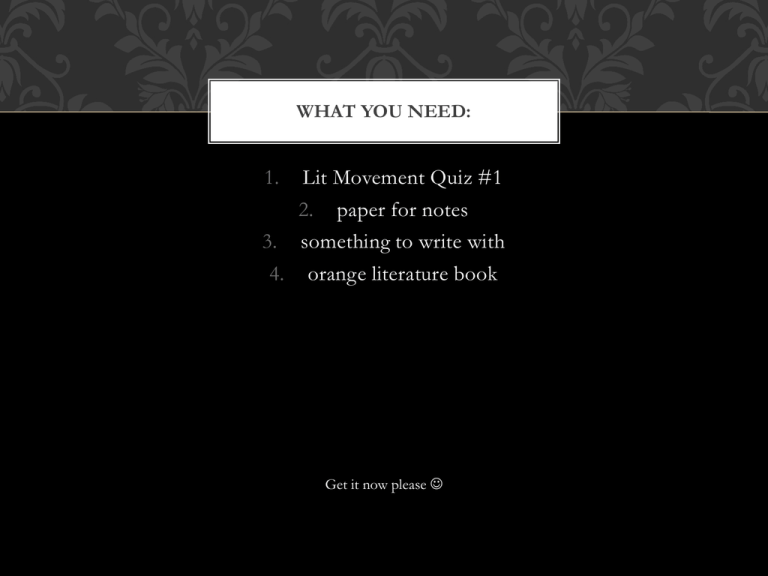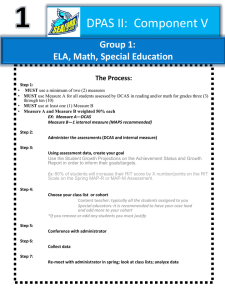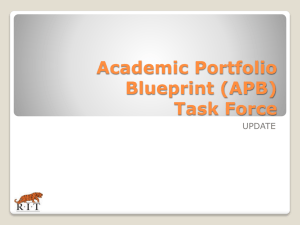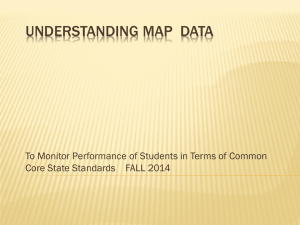Romanticism Notes - Elida Local Schools
advertisement

WHAT YOU NEED: 1. Lit Movement Quiz #1 2. paper for notes 3. something to write with 4. orange literature book Get it now please ROMANTICISM (1800-1855) OPPOSITION TO ENLIGHTENMENT • • • • • • strong focus on imagination and the human experience more short stories, novels, and poems an emphasis on fiction multiple interpretations of literature emphasis on emotions and feelings focus on the beauty of nature – raw, unspoiled nature RIT. 11-12. 3: Analyze a set of ideas or sequence of events – see how these ideas/events develop in a text RIT. 11-12. 4: Meanings of words and phrases (figurative, connotative, and technical) vocabulary. HISTORICAL CONTEXT PG. 134-135 • • • • Expansion of book publishing, magazines, and newspapers Industrial Revolution Abolitionist movement Two major divisions: • Dark romantics • Transcendentalists • Read “American Romanticism” pages 138-149 THE DARK ROMANTICS (1800-1840) GOTHIC LITERATURE • • • • • • Use of the supernatural Characters with good and evil intertwined Dark landscapes Dark use of imagination Unreliable narrators Combines fiction, horror, and romance* “SHE WILL COME TOMORROW” BY EDWIN DEAKIN (1888) • How does the painting reflect the ideas and/or characteristics of the dark romantics? RL. 11-12. 7: Analyze multiple interpretations RI. 11-12. 7: Evaluate multiple sources of information presented in different media. SL. 11-12. 1: Participate effectively in a range of conversations and collaborations with diverse partners/peers. WASHINGTON IRVING • • • • First famous American writer “Father of American Literature” Born 1789 in New York City Popularized the nickname “Gotham” for New York City • Died 1851 • Popular works: “Legend of Sleepy Hollow,” “Rip Van Winkle,” “Devil and Tom Walker” RI. 11-12. 7: Evaluate multiple sources of information presented in different media. NATHANIEL HAWTHORNE • Born 1804 in Salem, Massachusetts • Popular motifs are sin/guilt • Popular themes are the consequences of pride, greed, and selfishness • Distant relative of John Hathorne, a judge in the Salem Witch Trials • Died 1864 RI. 11-12. 7: Evaluate multiple sources of information presented in different media. EDGAR ALLAN POE ... Do you really need his background? … or his picture? • All his loved ones die… of TB • Awful childhood of abuse • Drunk… • Born 1809 • Created, and later popularized, the genre of short story and detective stories • Attacked two long standing conventions: poetry must be long and it must teach a lesson • Died 1849 • Only famous post-mortem RL. 11-12.: 1, 2, 4, 7, 10: Find textual evidence and infer, provide an objective summary, interpret unknown words/phrases, analyze multiple interpretations, read individually for comprehension SL. 11-12: 1, 2, 4, 5, 6: Collaborate in discussion and idea sharing, incorporate media, present information, adapt language for a presentation. PARTNER UP! With your partner/group: 1. Read your short story. 2. Clarify and summarize your short story. 3. Identify defining characteristics from the Romantic movement that apply to your short story. (Use textual evidence.) 4. Create a 5-minute presentation about your short story. Must be visual. (Your textual evidence must be clear in your presentation.) 5. Create a 10-point quiz over your short story and presentation. (Turn your quiz in before your presentation.) 6. Present! Presentations should be 5 minutes long, provide a summary of the text, utilize a visual aid. RL. 11-12. 9: Compare texts. W. 11-12. 10: Write routinely over extended time frames. WRITING – JOURNAL #3.1 – 1/23/2014 Which story did you enjoy the most? Why? What do you find between your own interests in fiction and these stories? Minister’s Black Veil Dr. Heidegger’s Experiment Ligeia The Facts in the Case of M. Valdemar The Fall of the House of Usher Rip Van Winkle Legend of Sleepy Hollow Devil and Tom Walker Young Goodman Brown RL. 11-12. 9: Compare texts. W. 11-12. 10: Write routinely over extended time frames Pick up a random journal from your class period. Consider the painting “She Will Come Tomorrow” pictured at the right. Choose one of the stories and explain how it can relate to the image. Dr. Heidegger’s Experiment, Young Goodman Brown, Legend of Sleepy Hollow, Rip Van Winkle, Ligeia, The Facts in the Case of M. Valdemar, The Fall of the House of Usher, Devil and Tom Walker, Minister’s Black Veil WRITING – JOURNAL #3.2 – 1/29/14 THE FIRESIDE POETS (1800-1840) RIT. 11-12. 2: Determine central ideas of texts, provide objective summary. RIT. 11-12. 3: Analyze complex set of ideas or sequence of events. RIT. 11-12. 10: Read and comprehend independently. READ: “AMERICAN MASTERS” PAGES 302-305 RL. 11-12. 2: Determine and compare central ideas of the texts. RL. 11-12. 9: Demonstrate knowledge of how two or more texts from the same period treat similar themes/topics. “AMERICAN MASTERS” Wa l t W h i t m a n • born 1819 Read: “I Hear America Singing” – pg. 311 “Song of Myself 10” – pg. 314 “Song of Myself 33” – pg. 316-317 “Song of Myself 52” – pg. 319-320 Emily Dickinson • born 1830 Read: “Success is counted sweetest” – pg. 345 “Because I could not stop for death” – pg. 347 RL. 11-12. 2: Analyze central themes of a text. “I HEAR AMERICA SINGING” • What is the speaker saying about the American people in Whitman’s poem? • What is the real theme of the poem? • Why do you think Whitman does not mention wealthy entrepreneurs, prominent leaders, or wealthy politicians in his poem? • Is Whitman idealizing the lot of workers, or do the songs express a positive and realistic aspect of American life? Explain. RL. 11-12. 4: Interpret and identify figures of speech and literary devices. RL. 11-12. 5: Analyze how author’s choices impact the overall aesthetics of the poem. “SONG OF MYSELF, 10” • Write down the literary terms on page 313. • What emotions does Whitman want you to feel? How can you tell? • Why does Whitman use these specific scenes in his poem? RL. 11-12. 1: Make inferences about the text and draw textual evidence to support inferences. RL. 11-12. 5: Analyze how author’s choice impacts poem. RL. 11-12. 9: Demonstrate knowledge of how texts treat similar themes/topics. “SONG OF MYSELF, 33” • What emotions does Whitman want you to feel in this poem? • Compare these emotions to “Song of Myself, 10.” • Find textual evidence of the speaker’s emotions. • Match the scene to the speaker’s emotion. • Complete the chart on page 318 of poetic devices. RL. 11-12. 9: Analyze how texts approach and treat similar themes. “SONG OF MYSELF, 52” • Compare the references to Nature among Whitman’s other poems. • Analyze the meaning of line 10. • Analyze the meaning of line 12. RL. 11-12. 5: Analyze author’s choices for impact. “SUCCESS IS COUNTED SWEETEST…” • Answer question #2 on page 346 under “Success is counted sweetest…” • Summarize the poem. • Why does Dickinson use these comparisons? RL. 11-12. 7: Evaluate various texts and their interpretations. RL. 11-12. 9: Compare how author’s treat similar topics in different texts. “BECAUSE I COULD NOT STOP FOR DEATH…” • Compare the personification of Death to Whitman’s personification of death. • Examine the 3rd stanza in comparison to the “Seven Ages of Man.” • Compare the 5th stanza to the riddle of the Sphinx. RL. 11-12. 7: Analyze multiple interpretations – including Shakespeare. RL. 11-12. 9: Demonstrate knowledge of previous century texts – how texts treat similar themes/topics. Emily Dickinson “SEVEN AGES OF MAN” BY WILLIAM SHAKESPEARE Seeking the bubble reputation All the world's a stage, Even in the cannon's mouth. And then the And all the men and women merely players; justice, They have their exits and their entrances, In fair round belly with good capon lined, And one man in his time plays many parts, With eyes severe and beard of formal cut, His acts being seven ages. At first, the infant, Full of wise saws and modern instances; Mewling and puking in the nurse's arms. And so he plays his part. The sixth age shifts Then the whining schoolboy, with his satchel Into the lean and slippered pantaloon, And shining morning face, creeping like snail With spectacles on nose and pouch on side; Unwillingly to school. And then the lover, His youthful hose, well saved, a world too wide Sighing like furnace, with a woeful ballad For his shrunk shank, and his big manly voice, Made to his mistress' eyebrow. Then a soldier, Turning again toward childish treble, pipes Full of strange oaths and bearded like the And whistles in his sound. Last scene of all, pard, That ends this strange eventful history, Jealous in honor, sudden and quick in quarrel, Is second childishness and mere oblivion, Sans teeth, sans eyes, sans taste, sans everything. RL. 11-12. 7: Analyze multiple interpretations of a theme. RIDDLE OF THE SPHINX What goes on 4 legs in the morning, 2 legs in the afternoon, and 3 legs at night? Man. PLEASE DO THE FOLLOWING… • Turn in Vocab List #14 to the tray. • Grab a lit book. • Paper & something to write with for notes. Thanks RIT. 11-12. 2: Determine central ideas of texts, provide objective summary. RIT. 11-12. 3: Analyze complex set of ideas or sequence of events. RIT. 11-12. 10: Read and comprehend independently. FIRESIDE POETS William Cullen Bryant - born 1794 - “Father of American Poetry” - died 1878 Read: Background pg. 165 “Thanatopsis” pg. 166 “June” - handout In the essay, “The Poetic Principle,” Poe writes: “The rhythmical flow, here, is even voluptuous – nothing could be more melodious. The intense melancholy which seems to well up, perforce, to the surface of all the poet’s cheerful sayings about his grave, we find thrilling us to the soul – while there is the truest poetic elevation in the thrill… the impression left is one of a pleasurable sadness.” RL. 11-12. 1. Cite strong and thorough textual evidence. RL. 11-12. 2. Determine two or more themes of a text. Analyze development over a text. RL. 11-12. 5. Analyze how an author’s choice for structure affects the text. RL. 11-12. 9. Demonstrate knowledge of how previous centuries literature compare themes and topics. “THANATOPSIS” • “thanos” – Greek – means death • “opsis” – Greek – meaning view or sight • English word “optic” comes from • Compare the personification of death to Whitman and Dickinson. • Consider the shift in tone between lines 17-30 and line 31 through the end of the poem. • Why discuss a couch on line 33? RL. 11-12. 1. Cite strong and thorough textual evidence. RL. 11-12. 2. Determine two or more themes of a text. Analyze development over a text. RL. 11-12. 5. Analyze how an author’s choice for structure affects the text. RL. 11-12. 9. Demonstrate knowledge of how previous centuries literature compare themes and topics. “JUNE” • Where is the shift in tone found in the poem? • How does “June” compare to “Thanatopsis?” VISUAL LITERACY: SCENE FROM “THANATOPSIS” BY ASHER DURAND (1850) RL. 11-12. 9: Demonstrate knowledge of 19th century foundational American literature – how different authors from the same time period treat similar topics. – (7: including Shakespeare). W. 11-12. 9: Draw evidence from literary texts to support analysis and reflection. W. 11-12. 10: Write routinely over extended frames of time. JOURNAL #3.3 – 1/31/14 Pick up YOUR journal. Consider all of the poems we’ve read this week. Many people fear death or the death of loved ones. Do you fear death? Are the attitudes and perspectives of death from the various authors comforting? Which author can you most relate to? On a completely different note – which author did you like best: Whitman, Dickinson, Bryant? Sign your journal with YOUR number. A Tout le Monde (Set Me Free) by Megadeth THE TRANSCENDENTALISTS (1840-1855) DEFINING TRANSCENDENTALISM • transcendentalism: stressed individualism, intuition, nature, and self-reliance • derived from the philosopher Kant, who called "all knowledge transcendental which is concerned not with objects but with our mode of knowing objects.” • dominated the thinking of the American Renaissance • the original hippies • find the beauty and meaning of life • Practical messages of confident self-identity, spiritual progress, social justice FAMOUS TRANSCENDENTALISTS RIT. 11-12. 2: Determine central ideas of texts, provide objective summary. RIT. 11-12. 3: Analyze complex set of ideas or sequence of events. RIT. 11-12. 10: Read and comprehend independently. FAMOUS TRANSCENDENTALISTS R a l p h Wa l d o E m e r s o n • Born in Boston, MA 1803 • Brought up in a religious household • Wife died of TB – questions religion • Leader of the transcendentalists • Nicknamed “Sage of Concord” • His writing helped establish the philosophy of individualism Read: “Ralph Waldo Emerson” pg. 179 Excerpt from “Self-Reliance” pg. 185 H e n r y D av i d T h o r e a u • • • • • Born in Concord, MA, 1817 Pupil to Emerson Never succeeded in much Involved in abolitionist movement Resisted materialism, chose simplicity, and individualism • Died of TB in 1862 • “Kindred Spirits” Read: “Henry David Thoreau” pg. 189 Excerpt from “Walden or Life in the Woods” pg. 193-204 Excerpt from “Resistance to Civil Government” pg. 211-216 RIT. 11-12. 1: Infer about the meaning of the text RIT. 11-12. 6: Determine author’s point of view in a text, analyze how it shapes the beauty of a text. FROM “NATURE” • Theme: Take the time to notice the beauty around you. • Emerson says, “To speak truly, few adult persons can see nature.” – Why? • Painting: “View from Mt. Holyoke, Northampton Massachusetts” by Thomas Cole RIT. 11-12. 1: Infer about the meaning of the text RIT. 11-12. 6: Determine author’s point of view in a text, analyze how it shapes the beauty of a text. “FEW ADULT PERSONS CAN SEE NATURE…” “Self-Reliance” Sand Raking You have 2 minutes. Keep in mind, this is an individual assignment. On a separate piece of paper, write down 10 possibilities for what this is… RIT. 11-12. 2: Determine central ideas of a text & provide objective summary. RIT. 11-12. 8: Delineate and evaluate reasoning in U.S. documents - essays “SELF-RELIANCE” PG. 185 • What is the running motif throughout the excerpt? • Why do you think following metaphors mean? • Planting corn: • Joint-stock company: Important quotes: • “To be great is to be misunderstood” • “Trust thyself; every heart vibrates to that iron string.” W. 11-12. 4: Produce clear, coherent writing W. 11-12. 9: Draw evidence from informational text to support reflection. W. 11-12. 10: Write over extended time frames. WRITING: JOURNAL #3.4: 2/4/14 Pick up your own journal and answer one of the following prompts: 1- Do you think there is too little or too much emphasis on self-reliance and individualism in America today? -OR2- One of the major focal points in Emerson’s philosophy was nonconformity. What is a major focal point of your own philosophy? Return to “Famous Transcendentalists” RIT. 11-12. 7: Evaluate different forms of media to address literature. “KINDRED SPIRITS” BY ASHER DURAND (1849) Return to “Famous Trascendentalists” RIT. 11-12. 2: Provide objective summary of the text. RIT. 11-12. 6: Analyze author’s point of view and purpose. RIT. 11-12. 10: Read and comprehend individually. “RESISTANCE TO CIVIL GOVERNMENT” Summary • Main points… You should take notes over what I’m saying… Important Quotes: “I think we should be men first and subjects afterward.” “For it matters not how small the beginning may seem: what is once well done is done forever.” W. 11-12. 4: Produce clear, coherent writing W. 11-12. 9: Draw evidence from informational text to support reflection. W. 11-12. 10: Write over extended time frames. JOURNAL: #3.5 – 2/7/14 In your own journal, write a response to the following question: Is the government necessary? Does Thoreau’s philosophy on civil disobedience have any correlation to your own philosophy where political matters are concerned? Why or why not? Remember to sign your journal with your number. RIT. 11-12. 2: Provide objective summary of the text. RIT. 11-12. 6: Analyze author’s point of view and purpose. RIT. 11-12. 10: Read and comprehend individually. “WALDEN, OR LIFE IN THE WOODS” • What does the excerpt “from Economy” tell you about Thoreau as a person? • According to the excerpt “from Where I Lived and What I Lived for,” why did Thoreau go into the woods? • Though he is constantly asked about loneliness, what does Thoreau think of loneliness as stated in “from Solitude?” • To what does Thoreau compare weeding a bean field to in “from The Bean Field?” Why does he make this comparison? • Why does Thoreau focus so much time on discussing the ants in “from Brute Neighbors?” Relate the situation with the ants back to the title of the section. • Additionally, why does Thoreau describe the situation with the loon in so much detail? What is the purpose? RIT. 11-12. 2: Provide objective summary of the text. RIT. 11-12. 6: Analyze author’s point of view and purpose. RIT. 11-12. 10: Read and comprehend individually. “WALDEN, OR LIFE IN THE WOODS” • According to “from Conclusion,” why does Thoreau leave Walden Pond? • In “from Conclusion,” what does Thoreau discover about himself from his time at Walden Pond? • To what does Thoreau compare society? Why does he make this comparison? Important Quotes: “Our life is frittered away by detail… simplify, simplify.” “Why should we live with such a hurry and waste life?” “That if one advanced confidently in the direction of his dreams, and endeavors to life the life which he has imagined, he will meet with success…” W. 11-12. 4: Produce clear, coherent writing W. 11-12. 9: Draw evidence from informational text to support reflection. W. 11-12. 10: Write over extended time frames. WRITING: JOURNAL #3.6 – 2/10/14 In your own journal, please respond to the following prompt: What elements of Romanticism did you enjoy the most? Why? What were you, as a unique individual, able to connect with? Sign your journal with your number.









